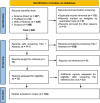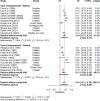A systematic review with meta-analysis of heritability estimates for temperament-related traits in beef and dairy cattle populations
- PMID: 38807564
- PMCID: PMC11629075
- DOI: 10.1111/jbg.12874
A systematic review with meta-analysis of heritability estimates for temperament-related traits in beef and dairy cattle populations
Abstract
Temperament (docility) is a key breeding goal in the cattle industry due to its direct relationship with animal welfare, cattle handler's safety and animal productivity. Over the past six decades, numerous studies have reported heritability estimates for temperament-related traits in cattle populations ranging from low to high values. Therefore, the primary objective of this study was to perform a comprehensive systematic review with meta-analysis to obtain weighted estimates of heritability for temperament-related traits in worldwide cattle populations. After data editing and quality control, 106 studies were included in the systematic review, of which 29.2% and 70.8% reported estimates of heritability for temperament-related traits in dairy and beef cattle populations, respectively. Meta-analyses were performed for 95 heritability estimates using a random model approach. The weighted heritability estimates were as follow: (a) flight score at weaning = 0.23 (95% CI: 0.15-0.32); (b) flight speed at weaning = 0.30 (95% CI: 0.26-0.33); (c) joint analysis of flight speed and flight score at weaning = 0.27 (95% CI: 0.22-0.31); (d) flight speed at yearling = 0.26 (95% CI: 0.21-0.30); (e) joint analysis of flight speed at weaning and yearling = 0.27 (95% CI: 0.24-0.30); (f) movement score = 0.12 (95% CI: 0.08-0.15); (g) crush score at weaning = 0.21 (95% CI: 0.17-0.25); (h) pen score at weaning = 0.27 (95% CI: 0.19-0.34); (i) pen score at yearling = 0.20 (95% CI: 0.17-0.23); (j) joint analysis of pen score at weaning and yearling = 0.22 (95% CI: 0.18-0.26); (k) cow's aggressiveness at calving = 0.10 (95% CI: 0.01-0.19); (l) general temperament = 0.13 (95% CI: 0.06-0.19); (m) milking temperament = 0.16 (95% CI: 0.11-0.21); and (n) joint analysis of general and milking temperament = 0.14 (95% CI: 0.11-0.18). The heterogeneity index ranged from 0% to 77%, and the Q-test was significant (p < 0.05) for four single-trait meta-analyses. In conclusion, temperament is moderately heritable in beef cattle populations, and flight speed at weaning had the highest weighted heritability estimate. Moreover, between-study heterogeneity was low or moderate in beef cattle traits, suggesting reasonable standardization across studies. On the other hand, low-weighted heritability and high between-study heterogeneity were estimated for temperament-related traits in dairy cattle, suggesting that more studies are needed to better understand the genetic inheritance of temperament in dairy cattle populations.
Keywords: behaviour; cattle; docility; genetic parameters; selection.
© 2024 The Author(s). Journal of Animal Breeding and Genetics published by John Wiley & Sons Ltd.
Conflict of interest statement
The authors declare no competing interests.
Figures









Similar articles
-
Genetic associations between flight speed and growth traits in Nellore cattle.J Anim Sci. 2012 Oct;90(10):3427-32. doi: 10.2527/jas.2011-5044. Epub 2012 May 14. J Anim Sci. 2012. PMID: 22585807
-
Genetic associations between temperament and performance traits in Nellore beef cattle.J Anim Breed Genet. 2015 Feb;132(1):42-50. doi: 10.1111/jbg.12117. Epub 2014 Aug 30. J Anim Breed Genet. 2015. PMID: 25174988
-
Immune competence traits assessed during the stress of weaning are heritable and favorably genetically correlated with temperament traits in Angus cattle1.J Anim Sci. 2019 Oct 3;97(10):4053-4065. doi: 10.1093/jas/skz260. J Anim Sci. 2019. PMID: 31581299 Free PMC article.
-
Genetics and genomics of reproductive performance in dairy and beef cattle.Animal. 2014 May;8 Suppl 1:105-21. doi: 10.1017/S1751731114000743. Epub 2014 Apr 4. Animal. 2014. PMID: 24703258 Review.
-
Invited review: Phenotyping strategies and genetic background of dairy cattle behavior in intensive production systems-From trait definition to genomic selection.J Dairy Sci. 2025 Jan;108(1):6-32. doi: 10.3168/jds.2024-24953. Epub 2024 Oct 9. J Dairy Sci. 2025. PMID: 39389298 Review.
References
-
- Agyemang, K. , Clapp, E. , & Van Vleck, L. D. (1982). Components of variance of Dairymen's workability traits among Holstein cows. Journal of Dairy Science, 65(7), 1334–1338. 10.3168/jds.S0022-0302(82)82350-3 - DOI
-
- Aitchison, T. E. , Freeman, A. E. , & Thomson, G. M. (1972). Evaluation of a type appraisal program in Holsteins. Journal of Dairy Science, 55(6), 840–844. 10.3168/jds.S0022-0302(72)85579-6 - DOI
-
- Alvarenga, A. B. , Oliveira, H. R. , Miller, S. P. , Silva, F. F. , & Brito, L. F. (2022). Genetic modeling and genomic analyses of yearling temperament in American Angus cattle and its relationship with productive efficiency and resilience traits. Frontiers in Genetics, 13, 794625. 10.3389/fgene.2022.794625 - DOI - PMC - PubMed
-
- Alvarenga, A. B. , Oliveira, H. R. , Turner, S. P. , Garcia, A. , Retallick, K. J. , Miller, S. P. , & Brito, L. F. (2023). Unraveling the phenotypic and genomic background of behavioral plasticity and temperament in north American Angus cattle. Genetics Selection Evolution, 55, 3. 10.1186/s12711-023-00777-3 - DOI - PMC - PubMed
-
- Antanaitis, R. , Juozaitienė, V. , Jonike, V. , Čukauskas, V. , Urbšienė, D. , Urbšys, A. , Baumgartner, W. , & Paulauskas, A. (2021). Relationship between temperament and stage of lactation, productivity and milk composition of dairy cows. Animals, 11(7), 1840. 10.3390/ani11071840 - DOI - PMC - PubMed
Publication types
MeSH terms
LinkOut - more resources
Full Text Sources
Miscellaneous

